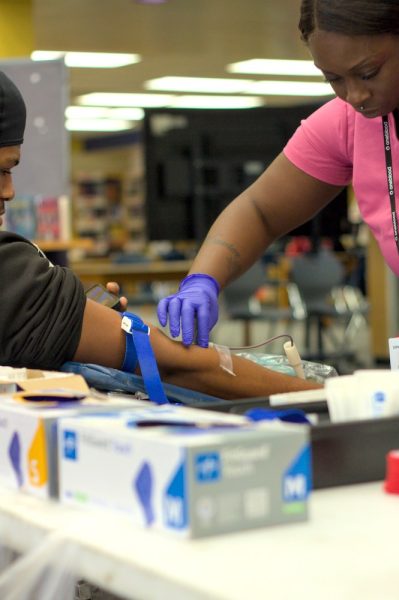Blood drives are an East Meck tradition held by JROTC and HOSA multiple times throughout the year. The students who participate sacrifice important class time and their own blood to save as many as hundreds of lives. However, according to the Red Cross, blood donations are the lowest they have been in 20 years. This decrease is particularly high in teenage donors.
Despite the urgent need, every blood drive, some students are left disappointed as they are turned away from donating.
“It is fairly common for deferrals to happen, for one reason or another,” OneBlood account representative Brian Anderson said. “Whether it be medications, iron levels or traveling to certain areas of the world.
Iron level, measured by hemoglobin, is an important threshold to meet when donating. Hemoglobin is a protein in the blood that carries oxygen, and a certain level of it is necessary for donated blood to be use and allow the donor to properly recover and regenerate new blood.
If a potential donor’s hemoglobin is under 12.5 grams per deciliter for women or 13 grams per deciliter for men, they are turned away and not allowed to donate.
This is discouraging for those running the blood drive because it is already difficult to find people willing to donate.
“A lot of kids say they are scared or don’t want to pass out,” doctor and former biomedical science teacher Pat Alfarone said. As former HOSA club advisor, Alfarone had overseen many East Meck blood drive. “But I think it’s more important to try and teach people how many lives they can be saving if they did.”


Women experience iron-related deferrals more frequently than men.
“I feel that a lot of girls get turned away, not so much the guys,” Alfarone said. “A lot of the girls who used to be able to give in the past aren’t able to give anymore.”
With this in mind, many believe it is imperative to educate students on blood iron and its importance to donation to prevent students from being turned away. This started with understanding how and why hemoglobin levels can change.
“Your [hemoglobin levels] can fluctuate on a daily basis,” Anderson said. “And when you’re younger, that happens even more often. Even though someone may be deferred on a blood drive on day, they might be able to donate the very next day depending on their iron levels.”
Being deferred because of low hemoglobin may be disappointing. Often, it leads students to question whether there is something to be concerned about. Though some East Meck students have reportedly discovered they have an underlying health condition after being unable to donate, it is important to note that not being able to donate does not equate to anemia or even a minor iron deficiency.
“Your iron level could be at a safe healthy level, but not at a level where you should donate blood,” Anderson said.
Alfarone believes that many people who have been previously deferred should not give up hope for donating.
“If you previously know your iron and hemoglobin are low, you can change the way you eat, over a longer period of time. You can supplement with iron supplements,” Alfarone said.
Anderson agrees that diet is an important factor to ensuring students can donate.
“What you’re taking in [is important], like protein-rich foods like chicken and beef, and leafy green vegetables,” Anderson said. “Having a healthy diet that’s high in iron would certainly suffice.”
Currently, blood drive are the only way awareness is being raised about blood iron in the East Meck community. Because of this, students continue to lose the chance to donate. If efforts to bring more awareness to this issue are successful, more patients could receive blood they need.









George Naum • May 13, 2025 at 10:04 am
This is interesting. I had not thought about how many people are unable to donate due to low iron levels, and how they would be discouraged to donate if they were turned away. I agree that there is a decent shortage in donating – I have not seen that many people giving blood recently when I go to donate. Is there a better way to incentivize or encourage donating so that more students/people outside of school are aware of the shortage? On top of this, is there a way to advocate for an iron-rich lifestyle so that people aren’t deficient?